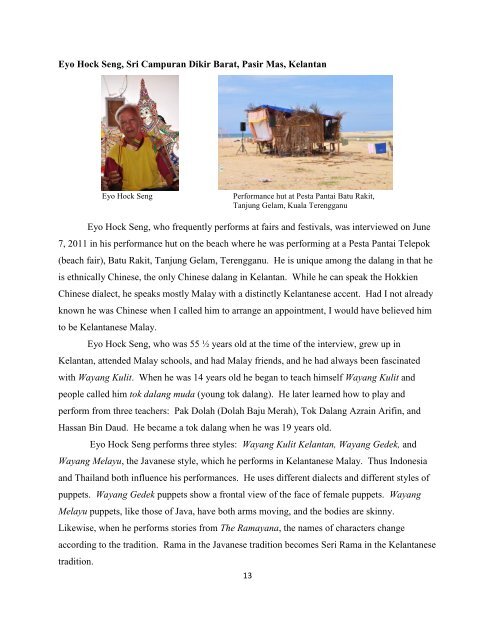Global Impact on the Survival of Wayang Kulit ... - Siew Lian Lim
Global Impact on the Survival of Wayang Kulit ... - Siew Lian Lim
Global Impact on the Survival of Wayang Kulit ... - Siew Lian Lim
Create successful ePaper yourself
Turn your PDF publications into a flip-book with our unique Google optimized e-Paper software.
Eyo Hock Seng, Sri Campuran Dikir Barat, Pasir Mas, Kelantan<br />
Eyo Hock Seng Performance hut at Pesta Pantai Batu Rakit,<br />
Tanjung Gelam, Kuala Terengganu<br />
Eyo Hock Seng, who frequently performs at fairs and festivals, was interviewed <strong>on</strong> June<br />
7, 2011 in his performance hut <strong>on</strong> <strong>the</strong> beach where he was performing at a Pesta Pantai Telepok<br />
(beach fair), Batu Rakit, Tanjung Gelam, Terengganu. He is unique am<strong>on</strong>g <strong>the</strong> dalang in that he<br />
is ethnically Chinese, <strong>the</strong> <strong>on</strong>ly Chinese dalang in Kelantan. While he can speak <strong>the</strong> Hokkien<br />
Chinese dialect, he speaks mostly Malay with a distinctly Kelantanese accent. Had I not already<br />
known he was Chinese when I called him to arrange an appointment, I would have believed him<br />
to be Kelantanese Malay.<br />
Eyo Hock Seng, who was 55 ½ years old at <strong>the</strong> time <strong>of</strong> <strong>the</strong> interview, grew up in<br />
Kelantan, attended Malay schools, and had Malay friends, and he had always been fascinated<br />
with <strong>Wayang</strong> <strong>Kulit</strong>. When he was 14 years old he began to teach himself <strong>Wayang</strong> <strong>Kulit</strong> and<br />
people called him tok dalang muda (young tok dalang). He later learned how to play and<br />
perform from three teachers: Pak Dolah (Dolah Baju Merah), Tok Dalang Azrain Arifin, and<br />
Hassan Bin Daud. He became a tok dalang when he was 19 years old.<br />
Eyo Hock Seng performs three styles: <strong>Wayang</strong> <strong>Kulit</strong> Kelantan, <strong>Wayang</strong> Gedek, and<br />
<strong>Wayang</strong> Melayu, <strong>the</strong> Javanese style, which he performs in Kelantanese Malay. Thus Ind<strong>on</strong>esia<br />
and Thailand both influence his performances. He uses different dialects and different styles <strong>of</strong><br />
puppets. <strong>Wayang</strong> Gedek puppets show a fr<strong>on</strong>tal view <strong>of</strong> <strong>the</strong> face <strong>of</strong> female puppets. <strong>Wayang</strong><br />
Melayu puppets, like those <strong>of</strong> Java, have both arms moving, and <strong>the</strong> bodies are skinny.<br />
Likewise, when he performs stories from The Ramayana, <strong>the</strong> names <strong>of</strong> characters change<br />
according to <strong>the</strong> traditi<strong>on</strong>. Rama in <strong>the</strong> Javanese traditi<strong>on</strong> becomes Seri Rama in <strong>the</strong> Kelantanese<br />
traditi<strong>on</strong>.<br />
13


